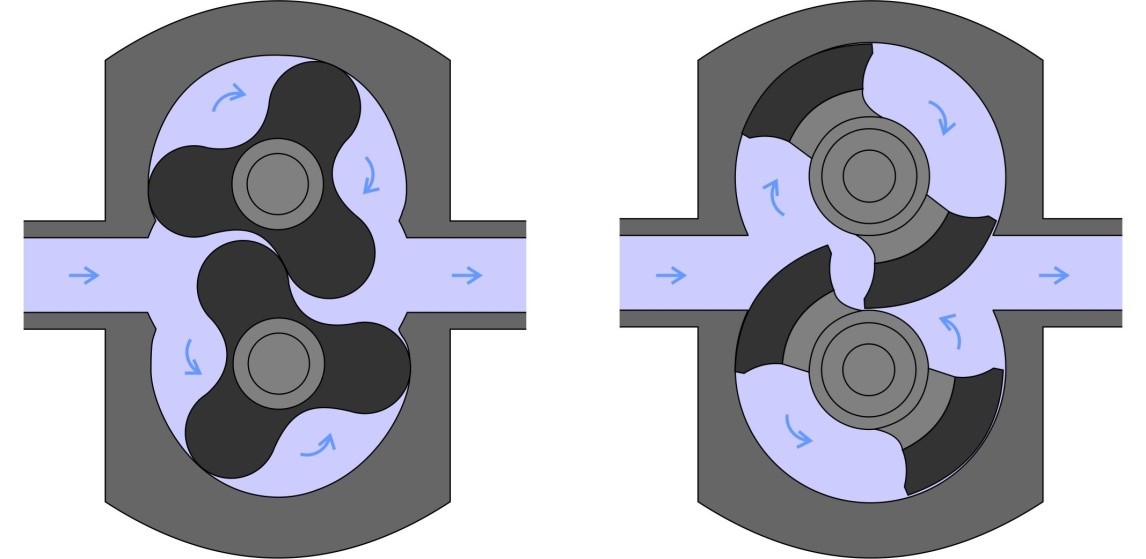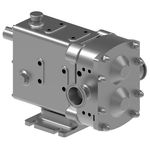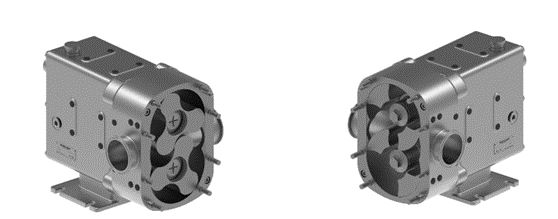Rotary Lobe Pumps or Circumferential Piston Pumps?
A comparison between two similar pump designs
Rotary lobe pumps (RLP) and circumferential piston pumps (CPP) are self-priming, rotary positive displacement pumps offering a smooth, non-pulsating, low shear flow. The two types of pump share similar technology differing only in rotor design. Both are used in food and beverage, dairy, cosmetic and pharmaceutical industries because of their gentle action on shear-sensitive liquids and slurries. Traditionally, rotary lobe pumps have been favoured in Europe and circumferential piston pumps in the US.
In construction, both designs feature twin rotors independently driven by a motor and gearing system. The rotors, mounted on parallel shafts, turn in opposite directions. Despite the small clearances, there is no direct contact between them. Suction is generated from an expanding cavity created by the precise interlocking of the rotors opposite the inlet. Pockets of fluid are carried around the outside path of the pump chamber, and expelled at the outlet port. The delivery rate is directly related to pump speed and, for a given feed viscosity, is unaffected by head pressure.
How do the rotors differ?
In a standard rotary lobe pump, the rotors each have three rounded lobes. However, there are also two, four or multi-lobe designs. In a circumferential piston pump, the rotors are larger and wing-shaped rather than rounded as in a lobe pump. Usually, the rotors have twin wings although single wing rotors may be preferred for pumping large solids. The rotors closely follow the curve of the pump casing, travelling in annular-shaped channels machined into the pump body. The wings also run in close clearance with the hub of the neighbouring rotor.

Rotor comparison: rotary lobe pump (left) and circumferential piston pump (right)
Construction
Rotary lobe and circumferential piston pumps are manufactured to comply with food safety regulations (such as FDA, EHEDG and 3A). Standard features include 316 stainless steel construction, polished surfaces, self-draining, sanitary seals, and easy disassembly for thorough cleaning and sanitation. The rotors in circumferential piston pumps are usually manufactured using high quality, non-galling nickel-based alloys because of the tight casing clearances.
Self-priming
Both rotary lobe pumps and circumferential piston pumps are capable of self-priming. However, the longer sealing paths and tighter clearances of the circumferential piston rotors produce excellent suction for self-priming.
Slip
In all positive displacement pumps, it is inevitable that a proportion of the pumped fluid leaks back from the discharge side to the suction side. This loss in performance is called ‘slip’. As well as the loss in performance and dosing accuracy, slippage is often a cause of wear, particularly with abrasive fluids. In both rotary lobe and circumferential piston pumps, slip occurs around the sealing paths between the rotors and case. Slip is a greater problem with low viscosity feeds (‘thin’ fluids) and at higher differential pressures. Circumferential piston pumps suffer from slip to a lesser extent because of the tighter clearances and the longer sealing path of the winged rotors.
Shear Sensitive Liquids
Many different types of fluids (for example: glues, paints, soaps, ketchup) undergo an increase or decrease in viscosity during pumping and, in some cases, this can be damaging, causing separation or setting. Fluids of this type are called shear-sensitive. Generally, shear can be minimised by selecting a pump with large clearances, and by running it very slowly. Rotary lobe pumps are generally preferred in these applications although circumferential piston pumps may also be considered.
Solids
The large cavities between the rotors in circumferential piston pumps are advantageous for transporting entrained soft solids. In addition, the rotors are designed with a scooped leading edge which keeps solids away from the rotor/case interface where they might be damaged or cause clogging, jamming or wear.
Cleaning
For hygienic applications, rotary lobe pumps are generally offered as CIP (clean in place) with some models available to allow SIP (sterilise in place). Circumferential piston pumps normally require COP (clean out of place) and offer easy disassembly with front panel access. Some models may offer a CIP option, such as the Viking Pump Hygienic Revolution series.
Summary
For many applications in food, beverage, dairy, cosmetic, and pharmaceutical industries there is little to choose between comparable rotary lobe and circumferential piston pumps. For hygienic applications, rotary lobe pumps often offer SIP or CIP capabilities as standard. In applications with low viscosity fluids, or with entrained solids or slurries, or where higher differential pressures and self-priming are important, a circumferential piston pump may be preferred.
| Feature | Rotary Lobe Pump (RLP) | Circumferential Piston Pump (CPP) |
| Rotor design |
|
|
| Sealing |
|
|
| Cleaning |
|
|
| Advantages |
|
|
Viking’s Revolution® Series offers both rotary lobe (left) and circumferential piston rotor (right) configurations.













